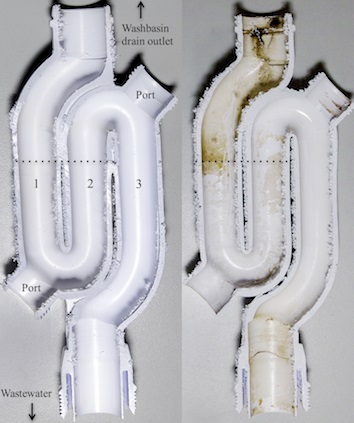Dublin Dental University Hospital Scientists and Engineers Develop an Automated System That Consistently Minimizes Microbial Contamination and Infection Risks From Hospital Hand Washbasin Drains and U-bends
A revolutionary and cost-effective approach to automatically minimising bacterial contamination and infection risks from hospital washbasin drains and U-bends has been developed by Dublin Dental University Hospital (DDUH) Microbiologists and Engineers according to research just published in the Journal of Hospital Infection. The DDUH Microbiology Unit funded the study.
Over the last two decades numerous studies from around the world have reported hospital outbreaks of bacterial infection, especially with the bacterium Pseudomonas aeruginosa, associated directly or indirectly with contaminated washbasin drains and U-bends. More recently, reports are increasingly highlighting the importance of washbasin wastewater pipework as a reservoir for hospital-acquired infections caused by carbapenem-resistant Enterobacteriaceae and Pseudomonas aeruginosa bacteria. According to the World Health Organization these bacteria are an emerging cause of hospital-acquired infection that pose a significant threat to public health. These bacteria are difficult to treat due to high levels of antibiotic resistance and are associated with high mortality. Severely ill patients and patients in high dependency units are particularly vulnerable to infection with these organisms.
Professor David Coleman, Dr. Emily Deasy, Ms. Elaine Moloney, Dr. Maria Boyle, Dr. Mary O’Donnell from the DDUH Division of Oral Biosciences (https://www.dentalhospital.ie/about/clinical-academic-divisions-and-hospital-departments/oral-biosciences) together with Mr. Jimmy Swan and Damien Geoghegan from the DDUH Facilities Department developed the automated system for decontaminating washbasin drains and U-bends and field-tested the technology for six-months in the Hospital’s clinics. At the outset of the study, untreated washbasin U-bends were coated with dense microbial biofilm harbouring hundreds of thousands to millions of bacteria, with P. aeruginosa predominating. In contrast, treated washbasin U-bends showed a complete elimination of biofilm and a consistent reduction in bacterial levels of 99.9%.
The novel decontamination system consisted of automatically filling washbasin U-bends, drains and wastewater pipes from below for short time periods sequentially with two solutions (catholyte and anolyte) generated by electrochemical activation (ECA) of a dilute salt solution using an ECA generator. Pipes were first cleaned with catholyte, which has detergent properties, and then disinfected with anolyte, a powerful environmentally friendly antimicrobial and biofilm-destroying disinfectant.
Commenting on the significance of the findings, Professor Coleman said: “The results of our study demonstrate that our approach to systematically destroying bacteria and biofilm throughout the wastewater pipes and U-bends connected to a hospital’s washbasin network provides a consistently effective and safe means of ensuring that washbasins are no longer reservoirs of contamination that can lead to patients becoming infected in hospitals. No other approach tested anywhere in the world is able to consistently achieve the level of microbial control we have managed. Our system has immense potential for widespread application in hospitals and can easily be scaled to simultaneously decontaminate a few or hundreds of washbasins. The system is controlled by a computer and can be programmed to operate when washbasins are not in use (i.e. late at night) and as frequently as desired”. The ECA solutions used to clean and decontaminate washbasin drains, U-bends and pipes are environmentally friendly. The ECA solution anolyte efficiently destroys all types of bacteria and viruses and is non-hazardous to use.
The paper has just been published in the leading international journal The Journal of Hospital Infection and is available open access in full here: https://www.sciencedirect.com/science/article/pii/S0195670118300550?via%3Dihub
Co-authors on the study are:
Emily Deasy BA (Mod.), PhD; Elaine Moloney BA (Mod.); Maria Boyle BSc, PhD; Jimmy Swan BSc, MSc; Damien Geoghegan; Mary O’Donnell, RDN, MSc, PhD and David Coleman, BA (Mod.), PhD, ScD, FTCD, MRIA from the Dublin Dental University Hospital.
Grainne Brennan BSc, MSc, PhD and Tanya Fleming BSc, MSc, The National MRSA Reference Laboratory at St. James’s Hospital
Full Citation:
Minimizing microbial contamination risk simultaneously from multiple hospital washbasins by automated cleaning and disinfection of U-bends with electrochemically activated solutions.
Deasy EC, Moloney EM, Boyle MA, Swan JS, Geoghegan DA, Brennan GI, Fleming TE, O'Donnell MJ, Coleman DC.
J Hosp Infect. 2018 Nov;100(3):e98-e104. doi: 10.1016/j.jhin.2018.01.012.
PMID: 29410281


